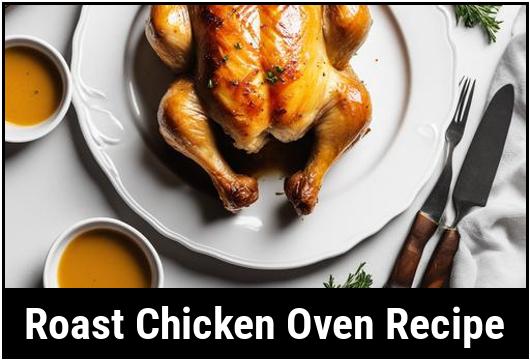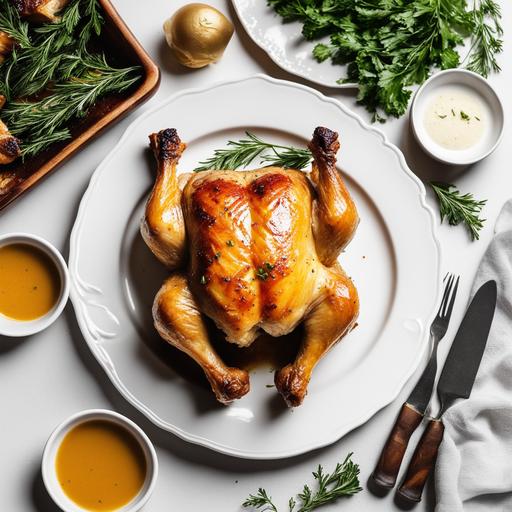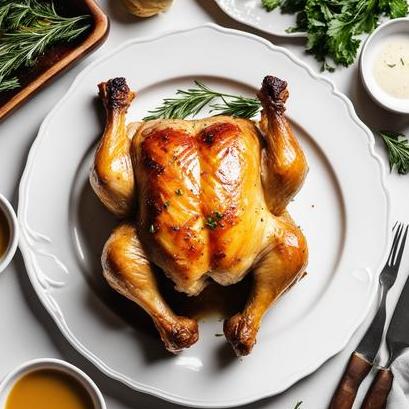
The Perfect Roast Chicken: An Oven Recipe That Will Make Your Taste Buds Dance
Roast chicken is a timeless classic that never fails to impress. There’s something magical about the combination of juicy meat and crispy skin that tantalizes our taste buds and promises a comforting, satisfying meal. In this article, we will delve into the depths of roast chicken mastery, exploring everything from food science to culinary details, giving you the knowledge and confidence to create a mouthwatering roast chicken right in your own oven.
Understanding the Food Science behind Roast Chicken
Roasting a chicken involves principles of heat transfer, chemistry, and even physics. The Maillard reaction, for instance, is central to achieving that delectable golden-brown crust. This reaction occurs when amino acids and reducing sugars, naturally present in the chicken’s skin, combine under high heat to produce a complex array of flavors and enticing aromas.
The high temperature of the oven also causes the proteins in the chicken to denature, resulting in a juicier interior. As the heat penetrates the meat, collagen fibers break down and melt into gelatin, enhancing both flavor and tenderness.
Culinary Details: Selecting the Perfect Chicken
For a truly fantastic roast chicken, selecting the right bird is key. Consider opting for an organic, free-range chicken if possible. These chickens tend to have a better flavor due to their natural diet and increased exercise.
When choosing your chicken, look for one that is plump and has smooth, supple skin. Avoid any bird that appears dry or discolored, as this may indicate poor quality or improper handling.
Cleaning and Preparing the Chicken

Before diving into the culinary journey of roasting a chicken, ensure it is well-prepared with proper cleaning. Follow these steps to ensure a clean and safe cooking process:
-
Remove the chicken from its packaging and pat it dry with paper towels. This step helps achieve a crispier skin.
-
Inspect the chicken for any remaining feathers or quills. Use tweezers to delicately remove them.
-
Rinse the chicken under cold water to eliminate any remaining impurities. Pat it dry again before proceeding to the next steps.
Tips for the Perfect Roast Chicken
Now that our chicken is ready for its transformation in the oven, let’s explore some essential tips to ensure a stunning outcome:
1. Achieving Crispy Skin
Crispy skin is a non-negotiable when it comes to roast chicken perfection. To achieve this, follow these steps:
-
Rub the chicken with a combination of olive oil, salt, and pepper. The oil helps promote browning while the salt draws out moisture, enhancing crispiness.
-
Ensure the chicken is completely dry before placing it in the oven. Moisture inhibits the skin from becoming crispy.
2. Flavoring the Meat
While a classic roast chicken is delicious on its own, there are various ways to infuse even more flavor into the meat. Some popular options include:
-
Stuffing the chicken cavity with herbs, garlic, and lemon. These aromatics will permeate the meat as it cooks.
-
Creating a flavorful marinade or dry rub to season the chicken beforehand. Experiment with your favorite herbs, spices, and even honey for a touch of sweetness.
3. Roasting Temperature and Timing
Roasting temperature and timing are critical factors in achieving a perfectly cooked chicken. Here’s a general guideline to follow:
-
Preheat your oven to around 425°F (220°C).
-
Place the chicken on a rack in a roasting pan or oven-safe dish.
-
Estimate around 20 minutes of cooking time for every pound (450 grams) of chicken.
-
The internal temperature of the chicken should reach 165°F (74°C) in the thickest part of the thigh. Ensure you use a meat thermometer to make accurate checks.
Variations to Elevate Your Roast Chicken
While the classic roast chicken recipe is a culinary masterpiece on its own, there are countless variations to explore. Here are a few exciting ideas to take your roast chicken game to the next level:
Garlic and Herb Roast Chicken
-
Mix minced garlic, chopped herbs like rosemary, thyme, and parsley, along with olive oil, salt, and pepper.
-
Rub this fragrant paste all over the chicken, including under the skin, to infuse maximum flavors.
Lemon and Herb Roast Chicken
-
Thinly slice a lemon and a few sprigs of your favorite herbs such as thyme or tarragon.
-
Place the lemon slices and herbs under the skin of the chicken, ensuring they are evenly distributed.
Spicy Paprika Roast Chicken
-
Create a dry rub using a combination of paprika, cayenne pepper, garlic powder, salt, and black pepper.
-
Massage this flavorful rub all over the chicken, allowing it to penetrate the skin and impart a delightful kick.
Checking for Doneness and Avoiding Common Pitfalls

Perfect timing is crucial to achieving a succulent roast chicken. Overcooking can result in dry meat, while undercooking poses health risks. To ensure your chicken is cooked to perfection, follow these steps:
-
Insert a meat thermometer into the thickest part of the thigh, avoiding contact with the bone. When the temperature reaches 165°F (74°C), the chicken is safely cooked.
-
Another test involves piercing the thickest part of the thigh with a skewer or the tip of a knife. If the juices run clear, the chicken is ready. If the juices appear pink or bloody, continue cooking.
The Foolproof Roast Chicken Oven Recipe
Without further ado, here’s a foolproof roast chicken recipe that covers all the key steps and tips we’ve explored:
Ingredients:
-
1 whole chicken (approximately 4-5 pounds)
-
Olive oil
-
Salt and pepper
Instructions:
-
Preheat your oven to 425°F (220°C).
-
Remove the chicken’s giblets if they are present. Rinse the chicken under cold water, then pat it dry with paper towels.
-
Place the chicken on a rack in a roasting pan or oven-safe dish.
-
Rub the chicken generously with olive oil, ensuring all sides are covered.
-
Season the chicken with salt and pepper, making sure to coat both the outside and cavity.
-
Roast the chicken in the preheated oven for approximately 20 minutes per pound (450 grams), or until the internal temperature reaches 165°F (74°C).
-
Once cooked, remove the chicken from the oven and let it rest for 10-15 minutes before carving.
Overcooking and Undercooking: What to Do?
Unfortunately, even with precise measurements and timings, there’s still a chance of overcooking or undercooking your chicken. Here’s what you can do in either case:
Overcooked Chicken:
- If your chicken turns out slightly dry, transform it into a delicious chicken salad, chicken tortilla soup, or chicken pot pie. By adding moisture and other flavorful ingredients, you can salvage your slightly overcooked meat.
Undercooked Chicken:
- If you find your chicken is undercooked, do not panic. Place it back in the oven and continue roasting. Keep checking the internal temperature until it reaches the desired 165°F (74°C). Patience and vigilance will save the day!
Conclusion
Congratulations! You’ve completed a comprehensive journey through the world of roast chicken. From understanding the food science behind the Maillard reaction to exploring a variety of culinary details, you now possess the knowledge and skills to create the perfect roast chicken in your own oven. Remember, practice makes perfect, so don’t be afraid to experiment with flavors and techniques to create your signature roast chicken recipe. Now it’s time to gather your ingredients, preheat that oven, and embark on a culinary adventure that will leave your taste buds dancing with delight!
Sources
FAQS On Roast Chicken Oven Recipe
What Temperature Should I Set My Oven To When Roasting Chicken?
To achieve a juicy and perfectly cooked chicken, preheat your oven to 425°F (220°C). This high temperature allows the chicken to brown beautifully while sealing in the juices.
How Long Should I Roast A Whole Chicken In The Oven?
The cooking time for a whole chicken depends on its weight. As a general rule, roast the chicken for about 20 minutes per pound (450 grams) when cooking at 425°F (220°C). So, for example, a 4-lb (1.8 kg) chicken should be roasted for approximately 1 hour and 20 minutes.
Should I Roast The Chicken Breast-side Up Or Down?
It is recommended to roast the chicken breast-side up. This allows the chicken to retain its moisture as the fat from the back and the juices from the dark meat seep into the breast which is naturally leaner. Furthermore, cooking the chicken this way ensures a more even browning on the top surface.
How Do I Know When The Chicken Is Done And Safe To Eat?
The most reliable way to determine if the roasted chicken is fully cooked is by using a meat thermometer. Insert the thermometer into the thickest part of the thigh without touching the bone. The chicken should reach an internal temperature of 165°F (74°C) to ensure it is thoroughly cooked. Alternatively, you can pierce the chicken’s thigh with a skewer, and if the juices run clear with no sign of pink, it is also a good indicator of doneness.
Should I Let The Chicken Rest Before Carving It?
Yes, it is highly recommended to allow the roasted chicken to rest for at least 10-15 minutes before carving. Resting allows the juices to redistribute throughout the meat, resulting in a more flavorful and tender chicken. Cover the chicken loosely with foil during this time to help retain its warmth.



